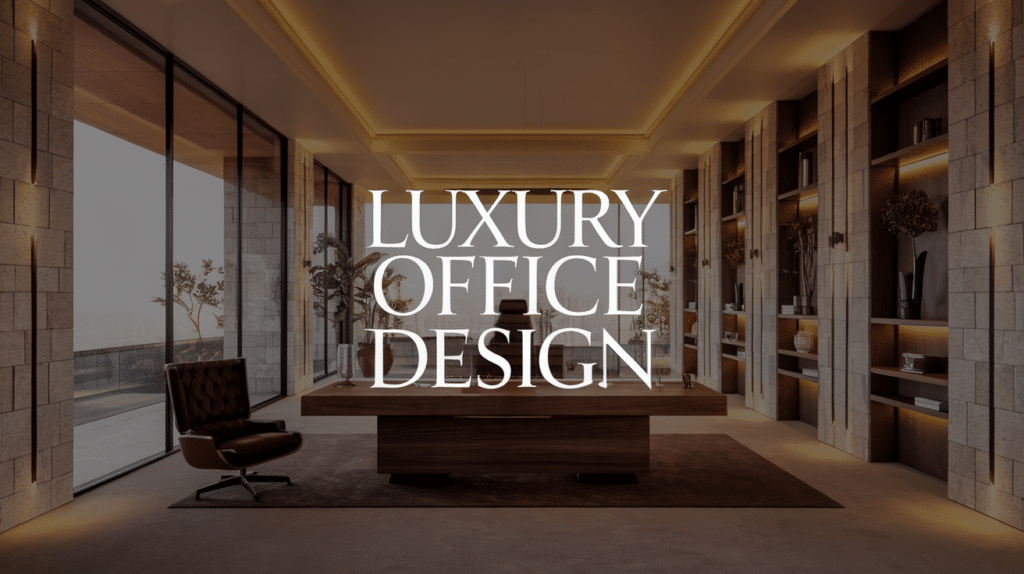A workspace should feel good to work in. It’s not just about a desk and a chair—it’s about how the space makes you feel.
Luxury office design helps create a space that looks clean and feels calm. It also sends a strong message to clients and coworkers. When the space looks put-together, people take your work more seriously.
But it’s not just for show. A well-planned office helps you focus and stay organized, so you’ll want to spend more time there and get more done.
Good design smartly uses light, layout, color, and texture. You don’t need to spend a lot or redo everything at once.
This post shares 16 clear ideas for improving your workspace. Each one is simple, modern, and easy to try. Start with one and see the difference it makes.
Luxury Office Design Ideas for Modern Spaces
The right design choices can turn a regular office into a smart and welcoming space. These ideas focus on comfort, style, and function. Start with one or two that fit your space, and add more as you go.
1. Use Clean Lines and High-End Materials
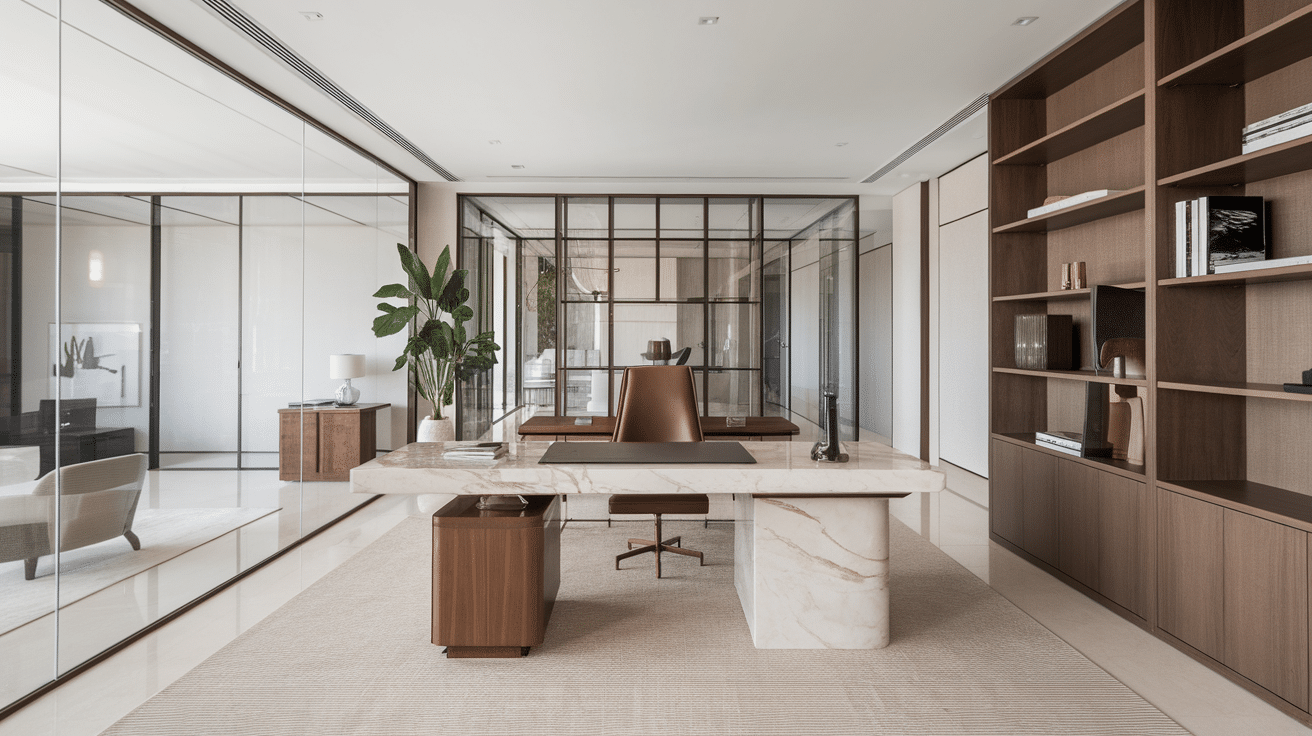
Clean lines help your office feel open and easy to use. They reduce visual noise and let each piece stand out. This style works well with modern layouts.
Marble surfaces bring in a smooth, cool feel. Use them for desks, counters, or accent pieces. They clean easily and look neat.
Wood adds warmth to the space. Try a wood desk or bookshelf with a simple design. Stick to light or medium tones for a modern look.
Glass is great for tables or doors. It keeps the space feeling open and bright and pairs well with metal and wood.
2. Add Statement Lighting
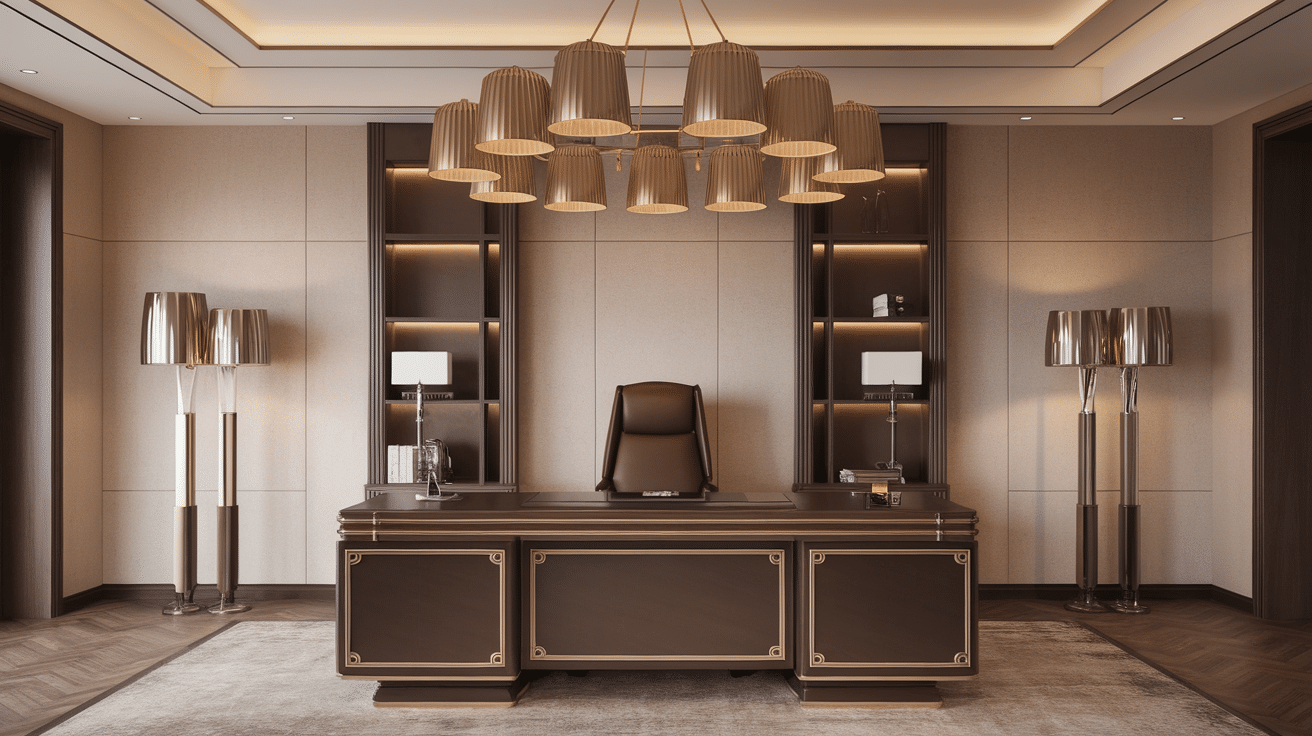
A bold light fixture can set the tone of the room. Hang it over the main desk or seating area. Make sure it fits the size of the space.
Look for lights in simple shapes but larger sizes. Black, brass, or matte finishes work well. These options keep the look strong without being too flashy.
Use a chandelier or sculptural light to add focus. It acts like a piece of art and draws the eye upward, adding balance to the room.
Let the main light work with smaller lamps. Floor lamps and desk lights add soft, focused light. Together, they create a cozy and useful space.
3. Invest in Ergonomic Designer Furniture
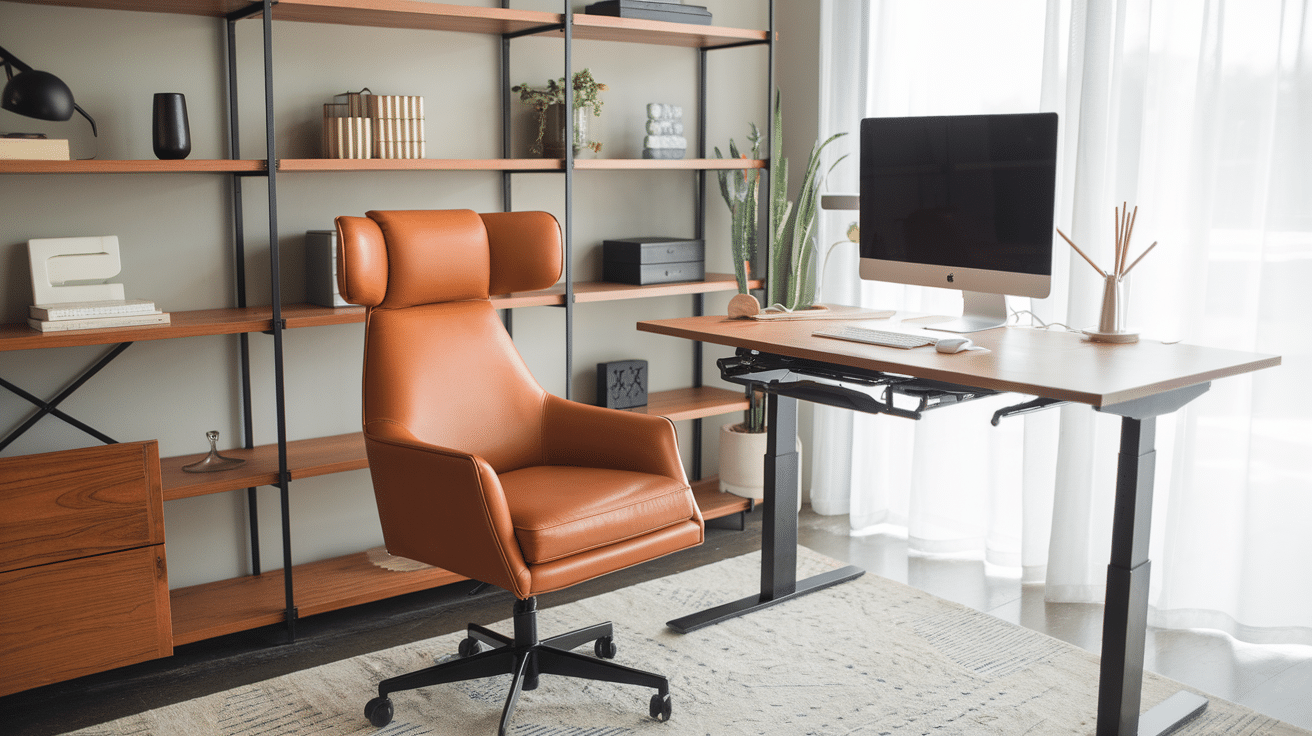
Comfort should always come first in a workspace. Choose a chair that supports your back and helps you sit well. The right seat can reduce strain during long hours.
Pick a desk that fits your work needs. It should offer space without feeling too large—simple designs with storage work best.
Look for furniture that’s both strong and simple. Metal legs or clean wood frames look neat and stay sturdy. These styles work well in any room.
If needed, add a footrest, keyboard tray, or armrest. These extras help your body feel better throughout the day. Small changes can make a big difference.
4. Feature a Minimalist Layout

A clean layout makes the room feel larger. Keep the center open and move larger pieces to the sides. This helps with walking space and comfort.
Use only the items you need each day. Keep shelves and surfaces clear. A clutter-free space feels calm and focused.
Make each zone work for one job. Have a desk for work, a chair for reading, and storage for extras. This keeps the space neat and organized.
Stick to a few main colors and materials. This will bring everything together and keep the room from feeling too busy.
5. Showcase Personalized Art and Sculptures
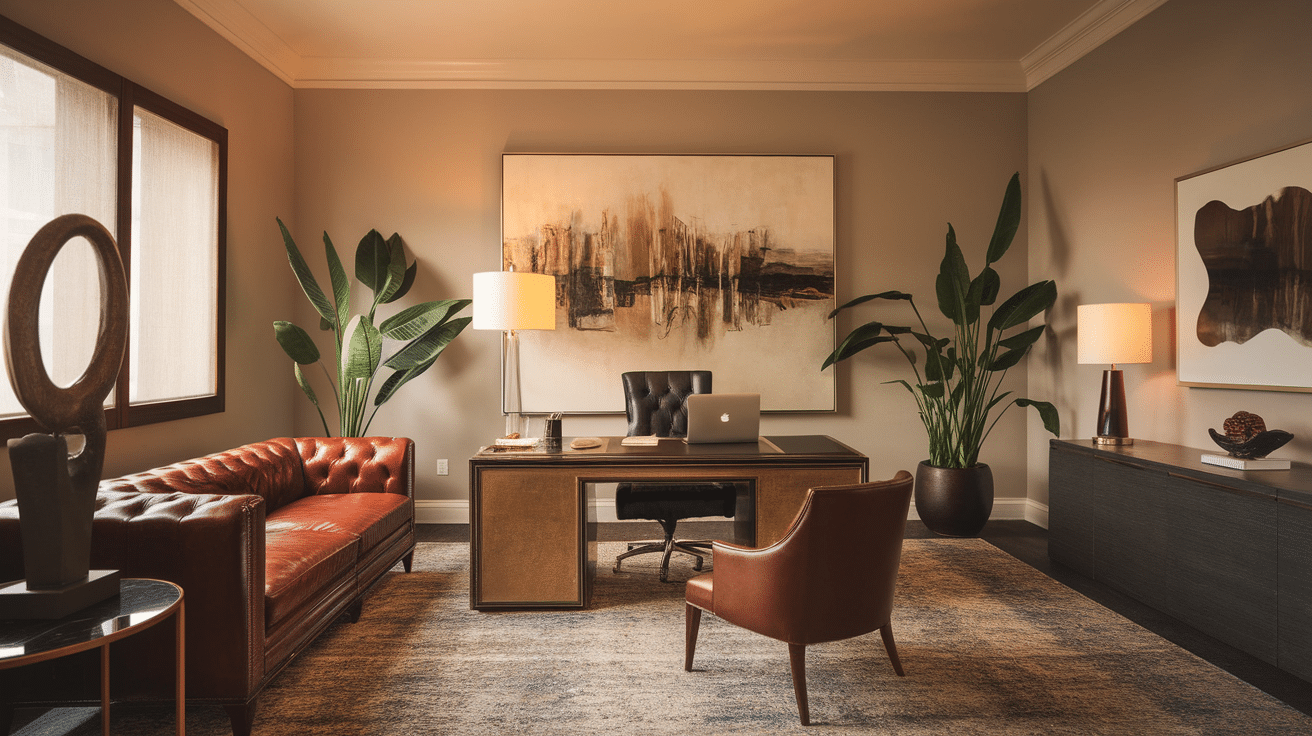
Art brings feeling and identity into a space. Choose pieces that reflect your taste or interests. They help make the office feel like yours.
You don’t need a lot of art. One large piece can be enough. Hang it where it can be seen without distraction.
Try a sculpture on a shelf or corner table. Small pieces add detail and interest. Pick clean designs that work with your layout.
Keep colors and shapes in line with your space. Art should stand out but still fit in, keeping the room balanced and not too loud.
6. Layer with Premium Textures
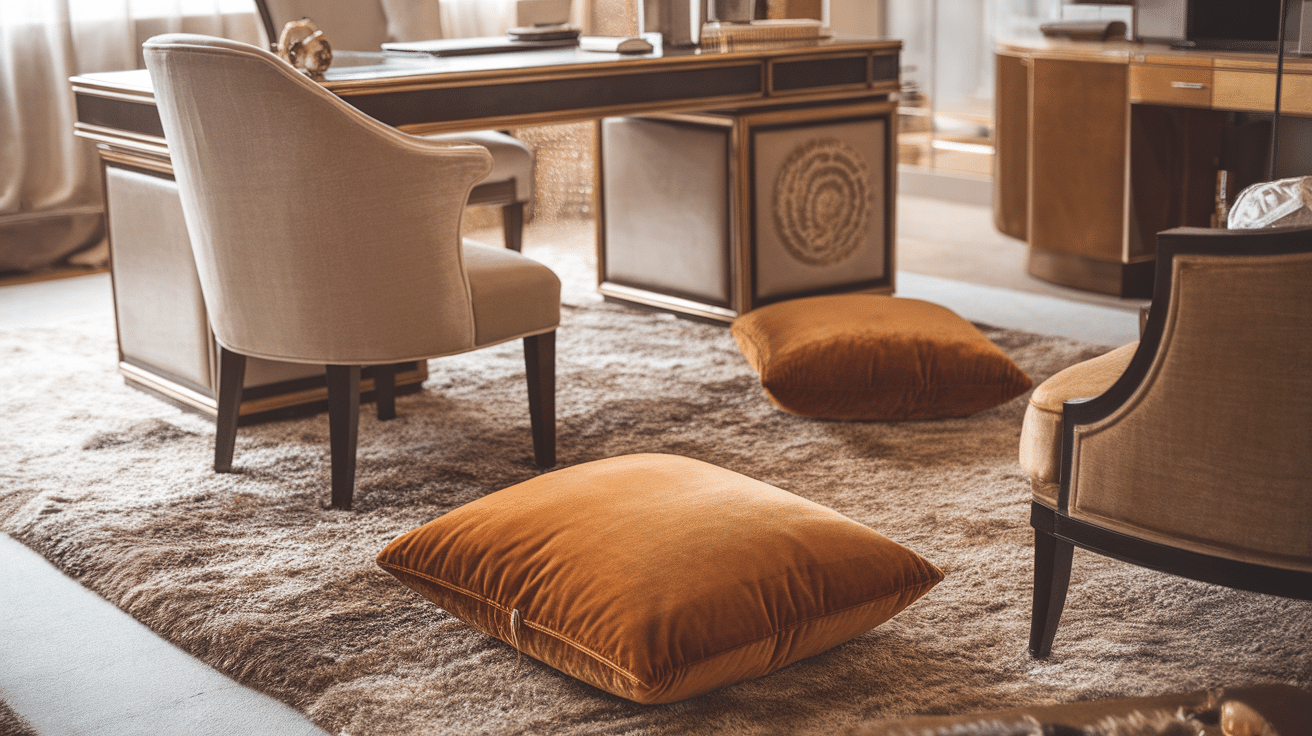
Mixing textures adds depth to your design. Soft rugs, smooth wood, and woven fabrics make the space feel complete. This also helps with comfort.
Velvet pillows or linen chairs bring in warmth. Try one textured piece per seating area. It adds variety without being too much.
Use textures on the walls, too. A cloth wall panel or padded headboard works well. These ideas soften sound and look nice.
Stick to a few materials. Repeat them in different places, such as chairs, rugs, and curtains, to give your room a steady look.
7. Create a Feature Wall or Backdrop
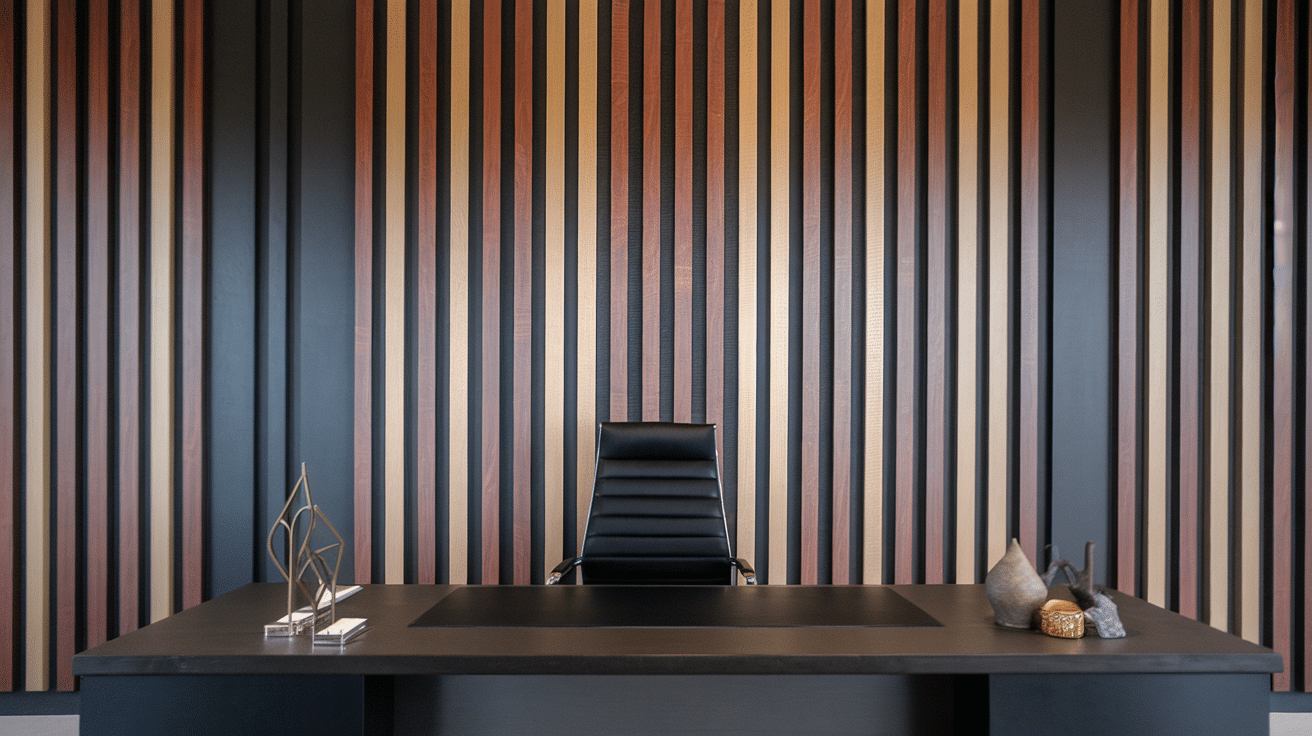
A feature wall can set the tone for your entire office. It adds focus and gives the space more depth. Place it behind your desk, a bookshelf, or the main seating area.
Paint is the simplest way to create a feature wall. Choose a rich color that complements your other elements. Deep gray, soft blue, or warm earth tones are good options.
Wood panels bring texture and warmth. Vertical slats or wide boards work well in modern rooms. You can use them alone or mix them with paint.
Wallpaper is another smart choice. Pick a subtle and neat pattern. It should stand out just enough to make the wall special but not too bold.
8. Use Natural Elements
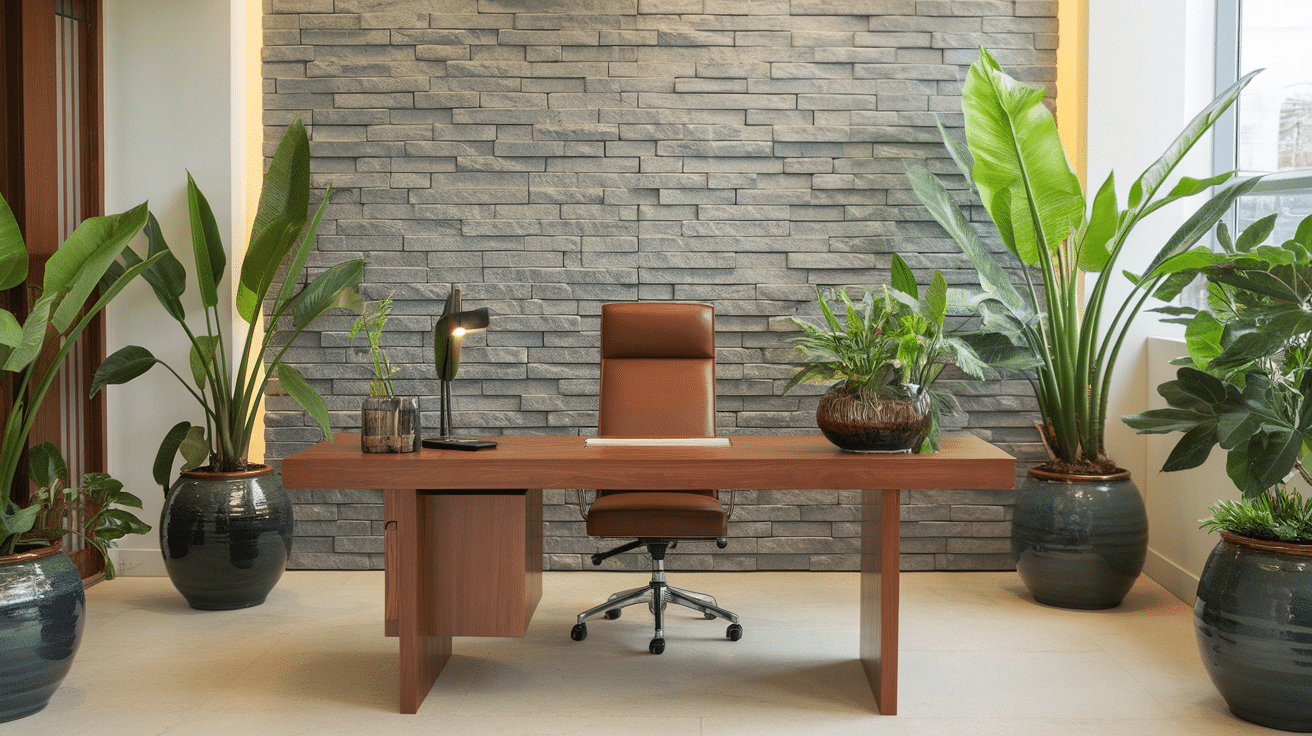
Natural items make the space feel calm. Stone, wood, or plants bring the outdoors in. These touches work in both large and small rooms.
A wood desk or shelf adds warmth. You can also use wood frames or wall panels. Stick to real finishes for the best look.
Plants clean the air and add color. Place a tall one in a corner or small ones on your desk. Use clean pots that match your space.
Stone accents work on floors, walls, or tabletops. They’re easy to keep clean and last a long time, helping ground the space.
9. Include Private Lounging Corners
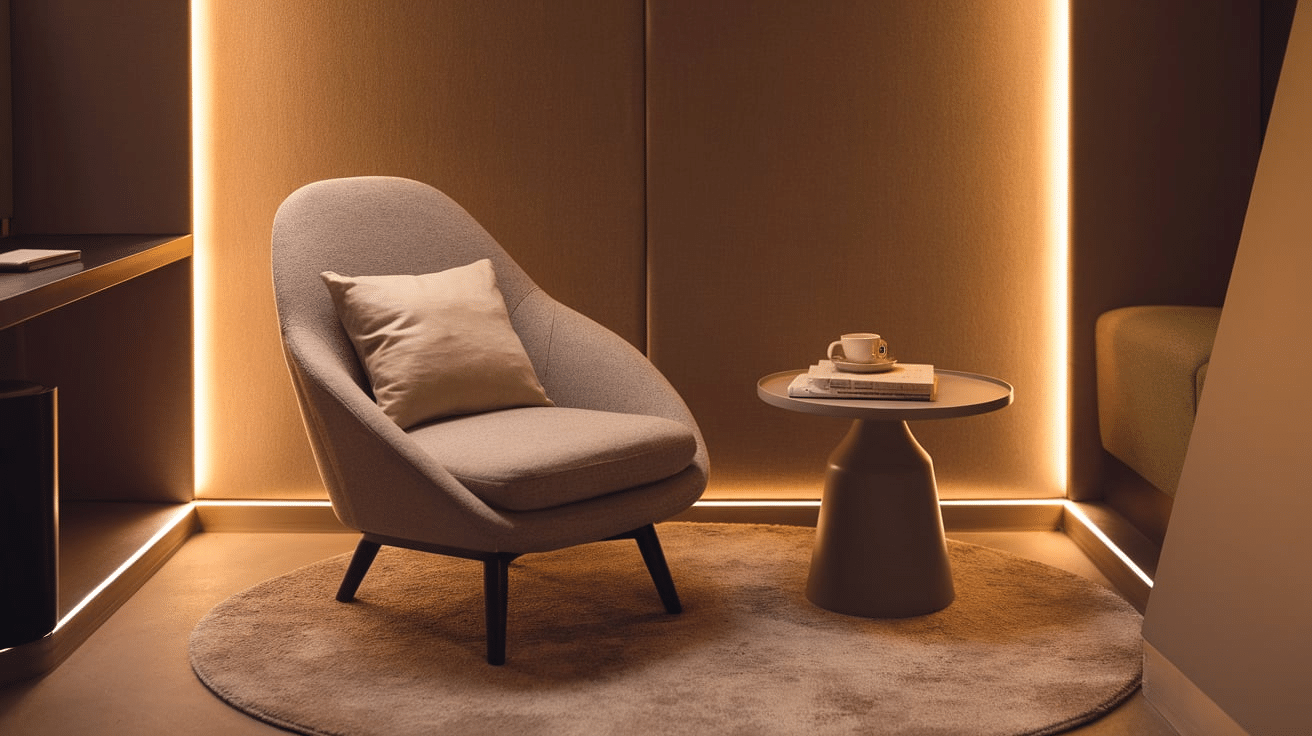
A small break space in your office helps you relax during the day. Use a quiet corner with a soft chair or bench. Add a side table for books, drinks, or notes.
Pick furniture that feels comfortable but doesn’t take up too much space. A reading chair or low bench works well. Add a soft rug to warm the area.
Use soft lighting in this spot. A floor lamp or wall sconce creates a calm feel. It’s great for resting between tasks.
Keep the corner simple and open. Let it feel like a break from the work zone. This space gives your office a sense of balance.
10. Focus on High-Quality Built-In Storage
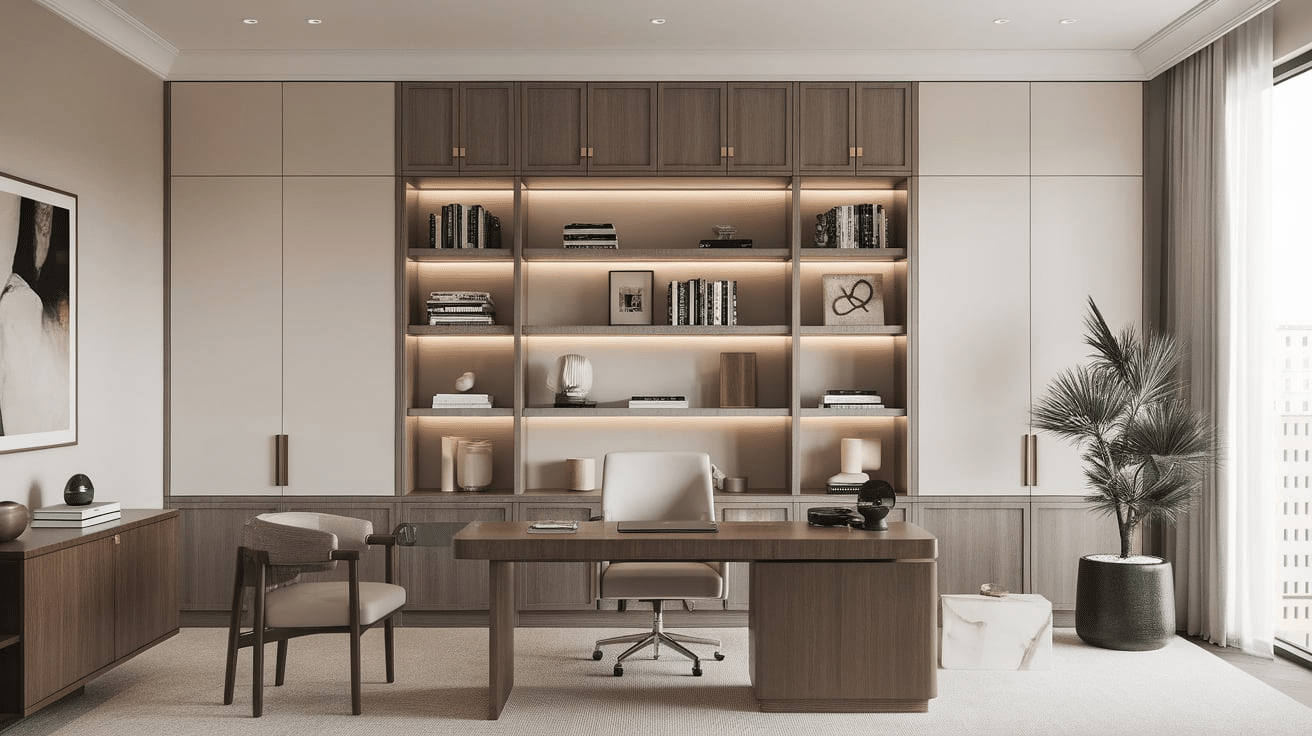
Built-in storage keeps your office tidy. Cabinets, drawers, and shelves hold all your tools and papers. They also blend in with the room’s design.
Choose wood or matte finishes that match your desk and walls. Keep handles and hardware simple. The storage should feel like part of the room.
Use closed cabinets for things you don’t need often. Open shelves can display books or a few nice objects. This mix keeps the space clean and lived-in.
Keep the storage low or high, depending on space. Don’t block windows or walkways. A neat setup makes the whole room feel better.
11. Embrace Neutral Colors with Bold Accents
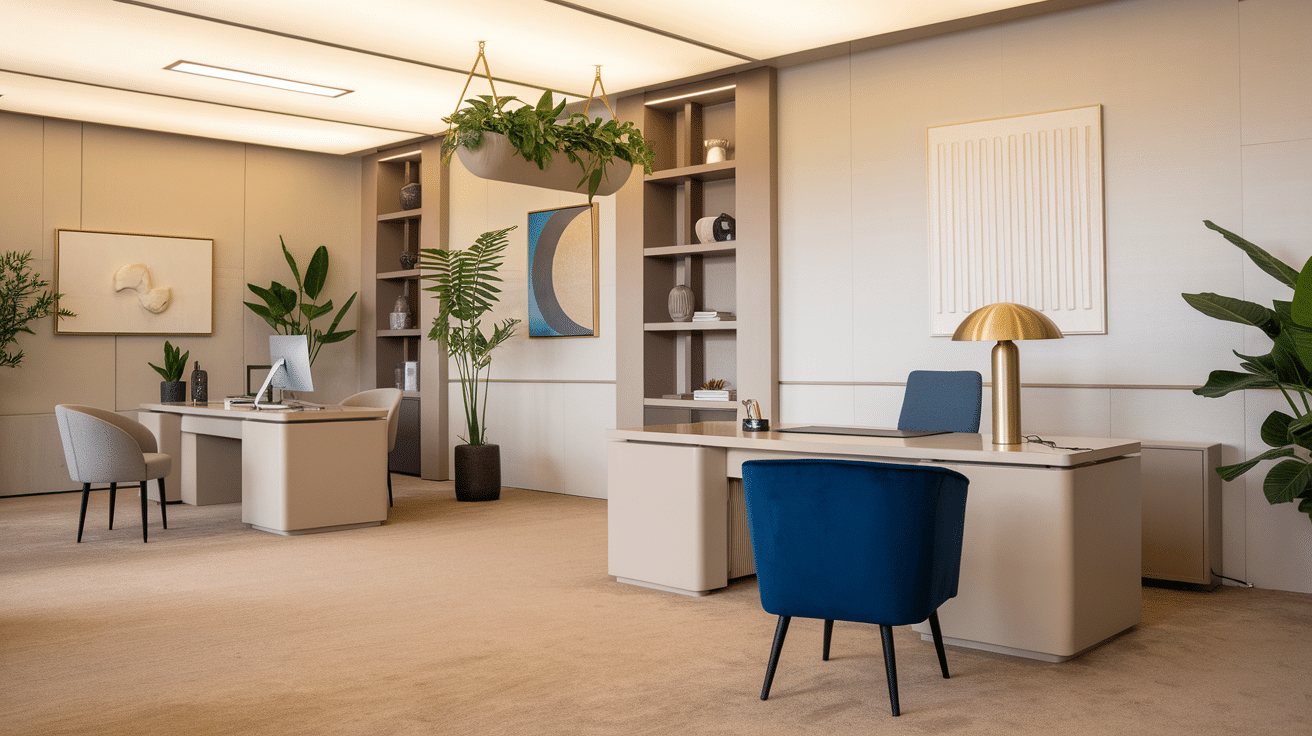
Neutral colors create a soft, calm base for your office. Use shades like white, beige, gray, or soft taupe. These colors help the space feel open.
Add bold accents to bring life to the room. Try a deep blue chair or a gold desk lamp. These details can make the space feel complete.
Stick to just one or two accent colors. This keeps things clean and easy on the eyes. A few strong pieces go a long way.
Let the bold pieces be useful, not just pretty. A colorful rug or bright shelf can do both. This way, the space stays simple but full of life.
12. Maximize Natural Light with Open Windows
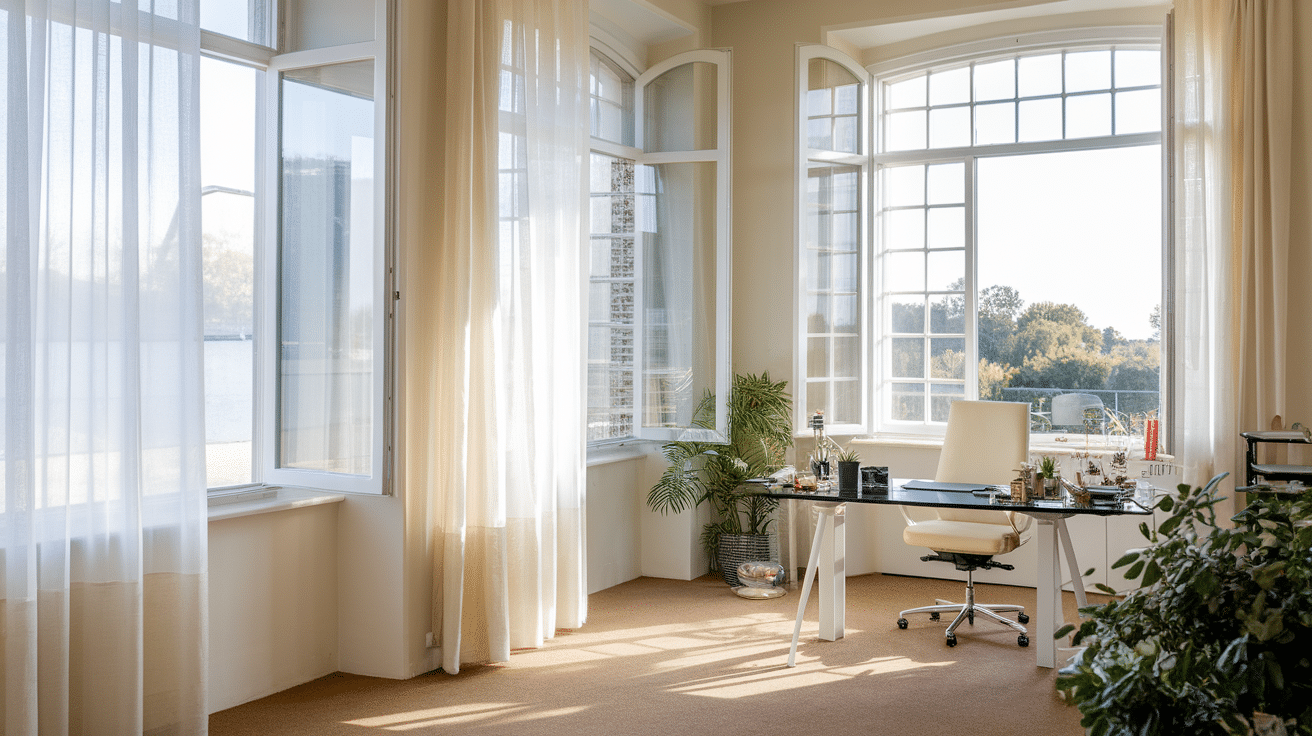
Natural light helps you stay focused and feel better in your space. Keep windows clear and open whenever possible. This makes the room feel larger and fresher.
Use sheer curtains or light blinds. They let daylight in while softening glare. Avoid thick drapes that block too much light.
If you need privacy, try frosted glass or light-filtering shades. These still let in brightness but help maintain a clean look.
Place mirrors near windows to reflect light. This spreads brightness around the room, making even darker areas feel more open.
13. Add Smart Tech Features
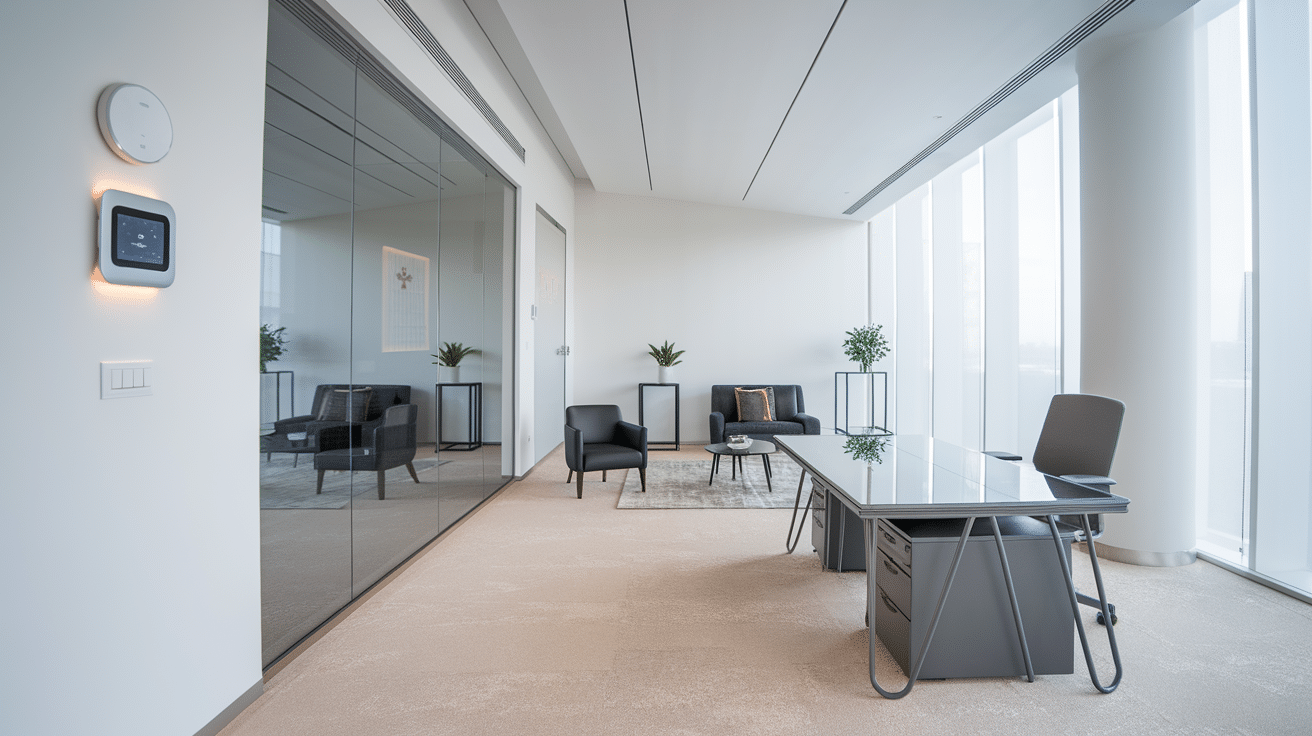
Smart features make your office more comfortable and easy to use. For example, you can install lights that you can control with your phone or voice, and a smart thermostat can keep the space just right.
These tools work quietly in the background. They don’t need to stand out or take over the design. You get modern function without clutter.
Place controls where they’re easy to reach. Use wall panels or apps for quick access. This helps you adjust things without losing focus.
Keep the tech simple and neat. Let it support the room instead of being the center of it. This keeps the space feeling smooth and clean.
14. Use Reflective Surfaces

Reflective surfaces help light move through your space, making the room feel bigger and brighter. Use them to highlight key areas.
Mirrors are a smart and stylish choice. Hang one across from a window to double the light. Pick a simple frame that fits the room.
Shiny tables or polished cabinets work well, too. They add brightness without standing out too much, and they can be used to break up flat textures.
Don’t overdo the shine. Mix it with softer surfaces like rugs or fabric chairs. This keeps the room balanced and easy on the eyes.
15. Build Multi-Use Work Zones

A good office supports more than one task. Use the layout to create zones for work, calls, or meetings. Each space should serve a clear purpose.
Use rugs or furniture to separate areas. A small table and two chairs can become a meeting spot, and a standing desk can create a focused corner.
Add shelves or dividers if you need more structure. These can help block sound or give more privacy. Keep them light and open if space is tight.
Each zone should feel like part of the same room. Matching colors and finishes tie everything together without feeling crowded.
16. Mix Traditional Touches in a Modern Layout
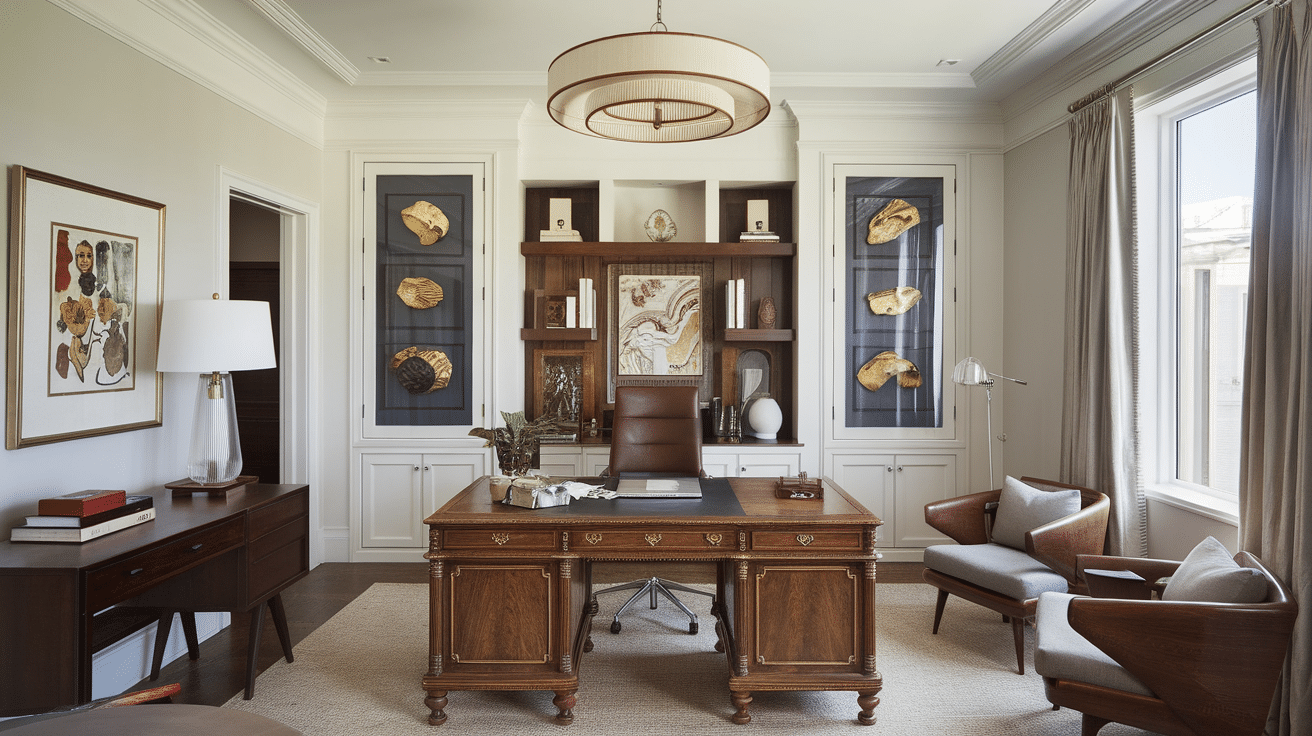
Classic pieces add depth to a modern office. Try a wood desk, framed artwork, or a chair with clean lines. These small details bring warmth.
Use molding or trim to add shape to the walls. Keep it simple and in line with the rest of the room. It adds a quiet layer of style.
Mix old and new materials. A modern light over a vintage table works well. Just keep the colors and shapes balanced.
Don’t overfill the space. Choose one or two classic touches and let them blend into the modern setting easily.
Luxury Home Office Design Tips
You don’t need a big space to create a luxury home office. What matters most is keeping it clean, calm, and easy to use. The tips below will help you build a setup that feels personal and works well day to day.
- Natural light: Place your desk near a window to brighten the space and lift your mood
- Built-in storage: Use cabinets or shelves to keep clutter out of sight
- Warm textures: Add soft rugs, fabric chairs, or linen curtains for comfort
- Quality lighting: Choose floor or desk lamps with soft bulbs to reduce glare
- Simple layout: Keep furniture spaced out for easy movement
- Quiet colors: Stick to soft tones to keep the room calm
- Personal details: Include items that reflect your style, like art or books
Conclusion
Designing your office with care can change how it feels to work every day. It’s not only about style—it’s about what works.
A space with the right layout feels open. Good lighting helps you focus, and texture and color add comfort. These small things make a big impact.
You don’t need to change everything at once. Start with one update, like better seating or a new light fixture, and build from there as your space and needs grow.
Let your office reflect how you like to work. Make room for calm, focus, and flow. A good office helps you think clearly and stay on track.
When you care about your space, it shows. Your office becomes a place that works for you—not against you. Simple choices can lead to a big change.


